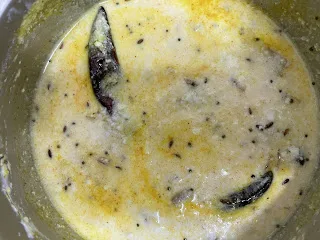Buttermilk Soup recipe | Yoghurt Charu Method | Buttermilk Broth recipe | Curd Soup recipe | Indian Buttermilk Soup | Refreshing Buttermilk Soup | Summer Buttermilk Soup | Buttermilk Soup with rice | How to make Buttermilk Soup | South Indian Buttermilk Soup recipe | Traditional Buttermilk Soup | Perugucharu recipe
Curd
Soup (Buttermilk Broth) Recipe:
- Preparation Time: 10 minutes
- Cooking Time: 10 minutes
- Total Time: 20 minutes
- Servings: 3-4
1. Introduction:
Curd Soup, also known as
Buttermilk Broth, is a traditional Indian dish celebrated for its cooling
properties and refreshing taste. It combines the tanginess of yogurt with a
medley of spices tempered in aromatic oil. This versatile recipe can be enjoyed
as a soothing summer drink or paired with rice for a wholesome meal.
2. Cultural Significance
of Curd Soup (Buttermilk Broth):
Curd Soup, known as
Buttermilk Broth in some regions, holds significant cultural value in Indian
culinary traditions. Beyond its refreshing taste and nutritional benefits, this
dish is deeply rooted in cultural practices and beliefs that span generations.
Here’s a closer look at its cultural significance:
Traditional Consumption:
In India, particularly in
South Indian states like Andhra Pradesh, Tamilnadu and Karnataka, Curd Soup is
a staple during hot summer months. It is not merely a dish but a culinary
tradition passed down through families. It is commonly prepared in households
where summers are intense, as it helps combat dehydration and heat exhaustion.
Ritual and Festive
Importance:
1. Temple Offerings: Curd-based
dishes, including variations of buttermilk broth, are often offered to deities
in temples as part of religious rituals and prayers. This practice underscores the
dish’s purity and its association with religious ceremonies.
2. Festival Feasts: During
festivals like Ugadi in Andhra Pradesh and Karnataka or Pongal in Tamilnadu,
Curd Soup often finds its place alongside other traditional dishes. It
symbolizes auspiciousness, abundance, and the joy of communal feasting.
Regional Variations:
Each region in India adds
its unique twist to Curd Soup based on local ingredients and culinary
preferences:
- North India: Here,
variations might include a touch of mint or roasted cumin powder, offering a
different flavor profile compared to its southern counterparts.
- South India: Known
for its spicier versions, with the inclusion of green chillies or pepper,
reflecting the region’s love for bold flavors and heat tolerance.
Culinary Heritage:
The preparation of Curd
Soup involves a technique called tempering (tadka), where mustard seeds, cumin
seeds, and other spices are heated in oil until they release their aromatic
oils. This method not only enhances flavor but also preserves cultural cooking
techniques that have been passed down through generations.
Social and Family Gatherings:
Beyond its ritualistic
significance, Curd Soup serves as a unifying element during family gatherings,
weddings, and community celebrations. It is a dish that brings people together,
fostering bonds and shared experiences around the dining table.
Modern Relevance:
In Contemporary times, as
awareness of health benefits grows, Curd Soup remains relevant for its
probiotic properties, aiding digestion and promoting overall gut health. It
continues to be a preferred choice for those seeking nutritious yet flavorful
alternatives to sugary beverages or artificial drinks.
In essence, Curd Soup
(Buttermilk Broth) transcends its role as a mere dish; it embodies cultural
heritage, religious practices, and social gatherings in India. Its simplicity
in preparation belies its profound significance in culinary traditions, making
it a cherished part of everyday meals and festive feasts alike. Whether enjoyed
for its cooling properties in hot climates or for its comforting flavors during
social occasions, Curd Soup stands as a testament to the rich tapestry of
Indian cuisines and cultural practices.
3. Importance of
Ingredients:
- Curd (Yogurt): The
primary ingredient, yogurt, is rich in probiotics that promote gut health and
digestion. It's also a good source of calcium and protein.
- Spices
(Mustard Seeds, Cumin Seeds, and Turmeric): These spices not only
enhance the flavor but also offer medicinal properties such as
anti-inflammatory and antioxidant effects.
- Onion
and Green Chillies: These add a layer of freshness and mild heat to the dish,
complementing the creamy texture of the curd.
4. Occasions and Who Can
Enjoy It:
Curd Soup is enjoyed across
India, particularly during hot summer months, as it helps in cooling down the
body and preventing dehydration. It's suitable for all ages and can be served
at family gatherings, festive occasions, or simply as a light meal on a warm
day.
5. Benefits
and Uses of Having This Recipe:
- Hydration and Cooling: Its
buttermilk base helps in staying hydrated and cool during summer.
- Digestive
Aid: Yogurt and spices aid digestion and promote gut health.
- Versatility: Can
be enjoyed as a drink or paired with rice, making it a flexible dish for
different meals.
6. Ingredients:
- 250 grams Curd
(plain yogurt)
- 1 large Onion,
finely chopped
- Salt, to taste
- 2 Green
Chillies, chopped (or 2 tsp Chilli Powder)
- 2 tsp Oil
- 1 tsp Mustard
Seeds
- 1 tsp Cumin
Seeds
- 1/2 tsp Turmeric
Powder
- 1 tsp Bengal
Gram (Chana Dal)
- Few Curry Leaves
- 2 Dry Red
Chillies
7. Detailed
Cooking Instructions:
Step-by-Step Method:
1. Preparation:
- Begin by
chopping the onion and green chillies. In a mixing bowl, whisk the curd until
smooth.
2. Tempering (Tadka):
- Heat 2 tsp
of oil in a kadai or pan over medium heat. Add mustard seeds and cumin seeds.
Allow them to splutter.
- Add Bengal
gram and fry until it turns golden brown.
- Now, add
turmeric powder, curry leaves, and dry red chillies. Sauté for about 1-2 minutes
until fragrant. Remove from heat and let it cool.
3. Mixing:
- Once the
tempered ingredients have cooled down, add them to the whisked curd.
- Add salt to
taste and mix well until all the ingredients are combined.
4. Serving:
- The Curd
Soup (Buttermilk Broth) can be served immediately as a refreshing drink or
alongside rice as a side dish.
8. Storage:
- Store any leftover Curd
Soup in the refrigerator for up to 2 days. Stir well before serving again.
9. Health Benefits and
Uses:
- Probiotic Rich: Supports
gut health and aids digestion.
- Cooling Effect: Ideal
for hot weather to stay hydrated and cool.
- Nutrient Dense: Provides
calcium, protein, and essential vitamins from yogurt and spices.
10. Cooking Tips and Variations:
- Consistency: Adjust
the consistency of the soup by adding water or more curd based on personal
preference. Some prefer it thinner, resembling a drinkable soup, while others
prefer it thicker to eat with rice.
- Spice Level: Modify
the amount of green chillies or chilli powder according to your spice
tolerance. For a milder version, remove seeds from green chillies before
chopping.
- Tempering Variations: Experiment
with different tempering ingredients like fenugreek seeds, asafetida (hing), or
grated ginger for added flavor profiles.
- Garnishes: Enhance
the presentation and flavor by garnishing with fresh cilantro leaves, grated
coconut, or a drizzle of ghee (clarified butter) before serving.
- Nutritional
Benefits: Highlight the nutritional benefits of this dish, such as its
probiotic properties from yogurt and cooling effect in hot weather due to its
buttermilk base.
11. Additional
Information:
- Cultural
Significance: In many Indian households, Curd Soup (Buttermilk Broth) is a
popular summer dish known for its cooling properties. It’s often consumed
during hot seasons to prevent dehydration and aid digestion.
- Health Benefits: Emphasize
the health benefits of curd, which is rich in calcium protein, and beneficial
bacteria that support gut health. The addition of spices like turmeric and
mustard seeds not only enhances flavor but also offers anti-inflammatory and
antioxidant properties.
- Preparation Tips: To
ensure the tempering (tadka) enhances the flavor of the soup, make sure the oil
is adequately heated before adding mustard seeds and cumin seeds. This step
allows the seeds to crackle and release their aroma into the oil.
- Traditional Serving: Describe
traditional ways of serving this dish, such as alongside a simple rice dish
like khichdi (rice and lentil porridge) or as a standalone refreshing drink.
12. Nutritional Information (Per
Serving):
- Calories: 120 kcal
- Carbohydrates: 10g
- Protein: 6g
- Fat: 6g
- Fiber: 2g
13. Presentation and
Servings:
- Garnish with fresh
cilantro leaves or a drizzle of ghee before serving.
- Serve in a chilled bowl
with rice or as a standalone drink.
Conclusion:
In conclusion, Curd Soup
(Buttermilk Broth) is a simple yet flavorful dish that embodies the essence of
Indian culinary tradition. Whether enjoyed for its cooling properties during
summer or as a nutritious addition to any meal, this recipe offers both taste
and health benefits. By exploring different variations and incorporating it
into your diet, you can experience its versatility and goodness. Prepare this
delightful dish to treat your senses and nourish your body with its wholesome
ingredients.
Curd Soup (Buttermilk
Broth) is a versatile and nutritious dish that combines the richness of yogurt
with aromatic flavors of Indian tempering spices. Whether enjoyed as a soup or
paired with rice, its cooling properties make it a perfect choice for hot
summer days. By adjusting spice levels and exploring different tempering
variations, you can personalize this dish to suit your taste preferences. Try
this recipe to experience a delightful blend of flavors and a boost of
probiotics in your diet!






Comments
Post a Comment